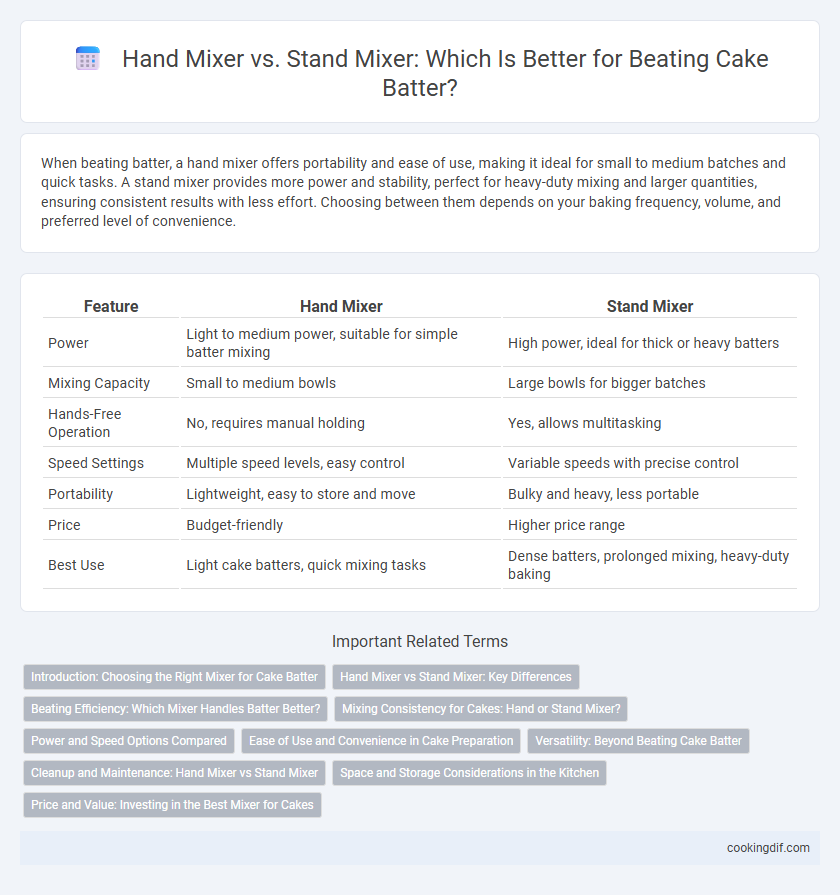When beating batter, a hand mixer offers portability and ease of use, making it ideal for small to medium batches and quick tasks. A stand mixer provides more power and stability, perfect for heavy-duty mixing and larger quantities, ensuring consistent results with less effort. Choosing between them depends on your baking frequency, volume, and preferred level of convenience.
Table of Comparison
| Feature | Hand Mixer | Stand Mixer |
|---|---|---|
| Power | Light to medium power, suitable for simple batter mixing | High power, ideal for thick or heavy batters |
| Mixing Capacity | Small to medium bowls | Large bowls for bigger batches |
| Hands-Free Operation | No, requires manual holding | Yes, allows multitasking |
| Speed Settings | Multiple speed levels, easy control | Variable speeds with precise control |
| Portability | Lightweight, easy to store and move | Bulky and heavy, less portable |
| Price | Budget-friendly | Higher price range |
| Best Use | Light cake batters, quick mixing tasks | Dense batters, prolonged mixing, heavy-duty baking |
Introduction: Choosing the Right Mixer for Cake Batter
Selecting the ideal mixer for cake batter hinges on the volume and consistency of your baking projects. Hand mixers offer lightweight maneuverability suited for small to medium batches, reducing fatigue during mixing, while stand mixers provide powerful motors and multiple attachments to handle larger quantities and tougher doughs effortlessly. Understanding the specific mixing needs ensures perfect aeration and smooth batter texture essential for moist, fluffy cakes.
Hand Mixer vs Stand Mixer: Key Differences
Hand mixers offer portability and ease of use for light to medium batter mixing, making them ideal for small batches and quick tasks. Stand mixers provide more power and stability, excelling at handling heavy or large quantity batters with consistent mixing results. Choosing between a hand mixer and a stand mixer depends on batter volume, mixing intensity, and kitchen space availability.
Beating Efficiency: Which Mixer Handles Batter Better?
Hand mixers offer greater control and maneuverability, making them ideal for small to medium batches of batter with precise beating requirements. Stand mixers provide superior beating efficiency for larger quantities due to their powerful motors and stable design, ensuring consistent mixing without fatigue. Overall, stand mixers handle thick, dense batters more effectively, while hand mixers excel in versatility for lighter, less demanding tasks.
Mixing Consistency for Cakes: Hand or Stand Mixer?
Stand mixers deliver more consistent mixing results for cake batter due to their powerful motors and multiple speed settings, ensuring even ingredient incorporation. Hand mixers offer greater control and flexibility but may struggle to maintain uniform mixing, especially with thicker batters. For achieving optimal cake texture, a stand mixer generally provides superior mixing consistency over a hand mixer.
Power and Speed Options Compared
Hand mixers typically offer power ranges between 100 to 250 watts, providing sufficient speed settings from 3 to 7 for versatile batter mixing. Stand mixers boast higher power, often between 300 to 1000 watts, with more speed options that can reach up to 10 settings, allowing for greater control and efficiency in beating dense or large batches of batter. The increased motor power and expanded speed selection of stand mixers ensure consistent mixing results and quicker processing times compared to hand mixers.
Ease of Use and Convenience in Cake Preparation
Hand mixers offer lightweight design and portability, making them ideal for quick tasks and small batches of cake batter, while stand mixers provide hands-free operation and consistent mixing power, streamlining the cake preparation process. The ergonomic grip of hand mixers reduces wrist strain during brief use, whereas stand mixers with tilt-head or bowl-lift features enhance convenience for longer mixing sessions and complex recipes. Choosing between the two depends on the volume of batter and frequency of baking, with stand mixers favored for frequent bakers requiring efficiency and hand mixers preferred for casual or occasional use.
Versatility: Beyond Beating Cake Batter
A hand mixer offers lightweight portability and precision for tasks like whipping cream and mixing small batches, ideal for quick and simple jobs. Stand mixers deliver powerful, consistent mixing with multiple attachments for kneading dough, making frosting, and even grinding meat, proving indispensable in complex baking processes. Their versatile design transforms them into all-in-one kitchen tools that extend far beyond just beating cake batter.
Cleanup and Maintenance: Hand Mixer vs Stand Mixer
Hand mixers offer easier cleanup with detachable beaters that can be quickly rinsed or placed in a dishwasher, making maintenance straightforward. Stand mixers require disassembling larger components such as the mixing bowl and attachments, which may demand more time but often come with dishwasher-safe parts for convenience. Regular cleaning and occasional lubrication of stand mixer gears are necessary to ensure optimal performance and durability.
Space and Storage Considerations in the Kitchen
Hand mixers offer a compact design that easily fits into drawers or small cabinets, making them ideal for kitchens with limited counter space and storage. Stand mixers require a dedicated area on the countertop or a spacious cabinet due to their larger size and heavier weight. Choosing between hand and stand mixers depends on the available kitchen space and storage preferences, with hand mixers providing greater portability and stand mixers typically offering more power for beating batter.
Price and Value: Investing in the Best Mixer for Cakes
Hand mixers offer affordability and portability, making them suitable for small batches and light cake batter mixing, often priced under $50. Stand mixers, typically ranging from $200 to $500, provide powerful motors and versatile attachments, delivering consistent results for dense or large-volume batters. Investing in a stand mixer yields long-term value through durability and multifunctionality, ideal for serious bakers seeking professional-quality cakes.
Hand mixer vs Stand mixer for beating batter Infographic

 cookingdif.com
cookingdif.com